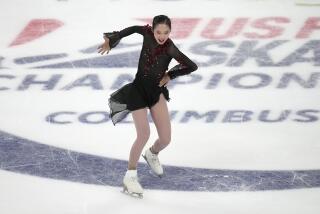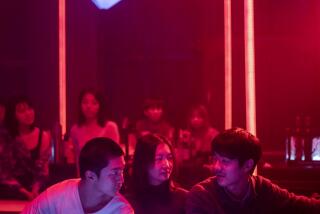Documentary : Chinese Do Figure-Eights Around Hardships : Winter in Beijing can be a sooty, frigid mess. But a little moonlight skating on the moat can work wonders.
- Share via
BEIJING — There are few things in life grimmer than winter in the Chinese capital.
Coal dust and soot from furnaces and stoves turn every surface a dull, brooding gray. Piercing, frigid winds howl down from Siberia. Chest colds, Beijing flu and bronchitis infect everyone, so bus and subway passengers form a chorus of hacking, wheezing sufferers. Frozen spittle coats the sidewalks.
Yet Beijingers, Chinese and foreigners alike, can look forward to the end of December, when the lakes and ponds of the city and environs freeze over.
This is the time, between Christmas and the Chinese Spring Festival (Feb. 10-12), for moonlight skating on the moat around the Forbidden City; for ice dancing and hockey matches on the frozen lakes of Beihai and Purple Bamboo parks, and for weekend frolics on the wide, wind-swept, frozen waters of the old and new Qing Dynasty summer palaces 10 miles northwest of Beijing.
In the booming “what next?” Chinese economy, it is probably only a matter of time before a flamboyant Hong Kong investor or the profit-seeking arm of the People’s Liberation Army opens up a giant shopping mall with an atrium ice-skating rink. As it is, Beijing now has only one year-round indoor rink, at the Capital Stadium.
Winter skating in Beijing is glorious not because one is on ice, but because of where that ice is. Few other places on earth offer such dramatic settings, redolent of history, for ice adventures.
For an admission charge of only two yuan, about 25 cents, for example, skaters at Beihai Park are entitled to two hours on the ice -- periodically swept and smoothed by broom-bearing maintenance crews -- at the foot of the White Pagoda Temple and Ming Dynasty Round City.
For the equivalent of 30 cents, visitors can rent skates or the chairs on runners known as bing che.
Getting outdoor exercise in Beijing is not always easy.
Street traffic is predatory, so jogging is not advised. Thousands of yellow taxi vans--called “bread loaves” by Beijingers--roam the streets in high-speed pursuit of pedestrians. Also, joggers must vie with bicycles and an increasing number of motorized tricycles for space on the streets.
But our family of four--including an 8-year-old girl and 5-year-old boy with seemingly limitless energy--quickly discovered that taking to the ice in Beijing was a way to get our exercise, encounter China and avoid the careening yellow bread loaves. As of this writing, no traffic fatalities have been reported on the ice of Beijing parks.
Still, it was a bit daunting for the middle-aged parents, whose closest previous contact with solid water not in a glass was a 1979 ice storm in Texas, to wobble out on the ice for the first time.
My wife, who believes that department store elevators move at dangerously high speeds, found security on the ice by holding on to the back of one of the bing che chairs and pushing it around while shouting, “Watch out! Watch out!”
I personally discovered that ice skating is actually aided by the middle-age--uhmm--”settling” of body mass. The center of gravity, lowered--in my case to a few inches above the ice surface--helps maintain balance and makes falling something less than life-threatening.
That part mastered, the neophyte foreign skater in Beijing is left with perhaps the most difficult challenge: ice skating while attempting to speak Chinese.
I believe that it was former University of Texas football coach Darrell Royal, or someone like him, who defined the most basic test of physical competence as the ability to walk and chew gum at the same time.
The next skill level is skating and speaking a foreign language at the same time.
Level three is skating and attempting to speak Chinese, a language nearly impossible to speak even when standing still.
Anyone with any experience here knows that Chinese people in parks are gregarious and inquisitive.
Skating in Beijing is an outdoor exercise experience punctuated by interrogation.
“Which country people are you?” is the most common demand, usually asked by someone skating maddeningly fast--backward.
However, on a recent evening outing under the lights at Beihai Park, I was startled by a questioner who demanded: “What age?”
It was only later that I realized the woman who posed the question was inquiring about one of my children, skating beside me at the time. But at the time, startled and vulnerable on the ice, feeling very much my age and more, all I could do was blurt: “47 years old.”
Thank God I was not chewing gum at the time.
In contrast to our incompetence on ice, many of the regular Chinese skaters are poetry in motion.
Zhang Meisheng, a retired building inspector, ice skates every day he can on Beihai Lake in the center of Beijing.
Around him on the ice, helmeted members of the Beijing City Young People’s Speed Skating Assn. blur past at astonishing velocities while their coach -- a “home-style” restaurant owner named Zhang Peng -- barks commands.
Couples tango and waltz near loudspeakers pouring out music. Uniformed soldiers of the People’s Liberation Army flail and helicopter their arms in a futile effort to avoid crashing. Lovers take turns pushing each other on the bing che chairs.
But Zhang Meisheng, 67, is a study in grace at his spot near the island in the middle of the lake.
Slowly, elegantly, he raises one leg in an arabesque, turns, reverses direction, his head and arms extended downward, almost touching the ice. Serenely, meditatively, he completes a few slow-motion spins. In the Chinese traditional marriage of sport and spirit, ice skating is the source of his qi-- his spiritual power, his force.
Ice skating, he said, is the way he keeps his health and his sanity: “Beijing is a place where it’s easy to get a cold. I’ve had maybe one cold in my life.”
When asked the best time to skate in Beijing, Zhang smiled toothlessly and began to recite the “Nine Nine” rhyme. Familiar to every schoolchild on the North China Plain, the rhyme recounts the “Nine Nine Phases” of winter.
Winter is divided into nine nine-day phases, set by the Chinese lunar calendar.
*
One nine, two nine: hands can’t show;
Three nine, four nine: on the ice go.
Five nine, six nine: river willows seen.
Seven nine -- ice crack .
Eight nine -- swallows back,
Nine nine and one nine more, oxen in the fields encore .
*
Like many poetic aspects of the Chinese language, the rhyme conforms to a seasonal rhythm, invariably tied to the cycle of planting and harvesting. The third and fourth phases of winter are considered the best time of all for skating.
“Most of my classmates don’t like it when winter comes,” said Nie Minhui, 23, a pretty, rosy-cheeked English teacher who recently graduated from the Beijing Foreign Language Normal College. “They all like summer. But I prefer winter, because of the skating.
“Three years ago I met my boyfriend here,” she said, pointing proudly to a tall, handsome young man leaning rakishly against a nearby guard rail.
Do they have plans to marry?
“Not yet,” said Nie coyly, punctuating her statement with a crisp pirouette.
“I want, she doesn’t,” interjected the boyfriend, Wu Kai, 23.
After skating in the park surrounded by Chinese culture, a popular apres-skating repair is Kentucky Fried Chicken.
The American company has a franchise, complete with life-size statues of the Colonel--one with a yellow complexion, the other pink--on White Pagoda Island in the center of Beihai Lake.
More to Read
Sign up for The Wild
We’ll help you find the best places to hike, bike and run, as well as the perfect silent spots for meditation and yoga.
You may occasionally receive promotional content from the Los Angeles Times.






